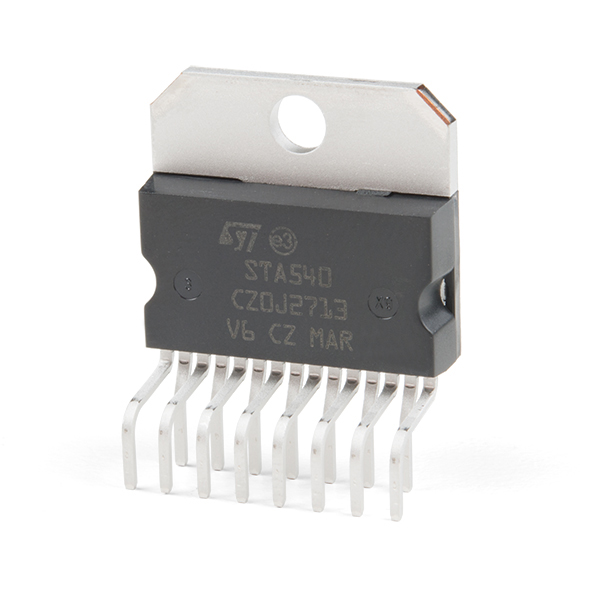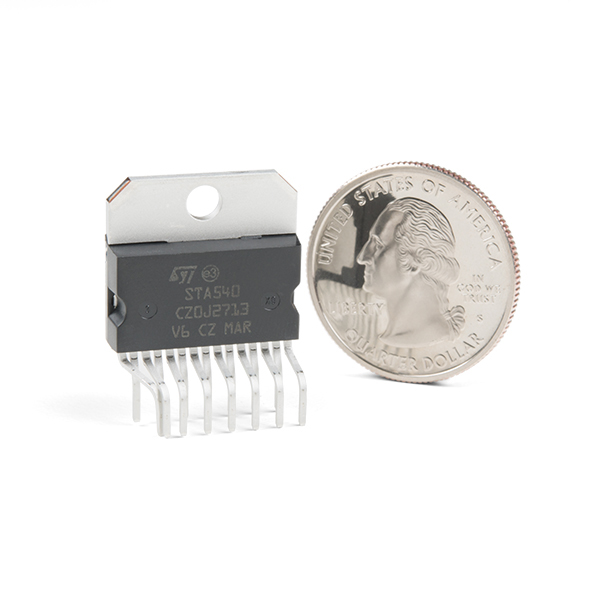The STA540 from STMicro is a 4-channel, class AB audio amplifier designed for high quality sound applications. The four independent channels makes this amplifier a great choice for a number of projects, with needs ranging from four speakers stereo (F/R) to two-speaker bridge solutions. The chip accepts a voltage supply ranging from 8 to 22VDC and has very high output power capability.
This chip comes in a staggered-lead Multiwatt-15 package. While our breakout board for the L298N isn't designed for it specifically, it will breakout out all pins of the STA540 to a more standard single row of 0.1" pitch headers. Also, keep an eye out for some upcoming amplifier products based on this chip!
It works great with the 6400BG Heatsink!
- High output power capability
- Standby function (CMOS compatible)
- Minimum external components count:
- no bootstrap capacitors
- no Boucherot cells
- internally fixed gain 20 dB
- No audible pop during standby operations
- Diagnostic facilities:
- clip detector
- output to GND short-circuit detector
- output to VS short-circuit detector
- soft short-circuit check at turn-on
- thermal shutdown warning
- Output AC/DC short circuit protection
- Soft short-circuit check at turn-on
- Thermal cutoff/limiter to prevent chip from overheating
Dual/Quad Power Amplifier - STA540 Product Help and Resources
Core Skill: Soldering
This skill defines how difficult the soldering is on a particular product. It might be a couple simple solder joints, or require special reflow tools.
Skill Level: Noob - Some basic soldering is required, but it is limited to a just a few pins, basic through-hole soldering, and couple (if any) polarized components. A basic soldering iron is all you should need.
See all skill levels
Core Skill: Programming
If a board needs code or communicates somehow, you're going to need to know how to program or interface with it. The programming skill is all about communication and code.
Skill Level: Rookie - You will need a better fundamental understand of what code is, and how it works. You will be using beginner-level software and development tools like Arduino. You will be dealing directly with code, but numerous examples and libraries are available. Sensors or shields will communicate with serial or TTL.
See all skill levels
Core Skill: Electrical Prototyping
If it requires power, you need to know how much, what all the pins do, and how to hook it up. You may need to reference datasheets, schematics, and know the ins and outs of electronics.
Skill Level: Competent - You will be required to reference a datasheet or schematic to know how to use a component. Your knowledge of a datasheet will only require basic features like power requirements, pinouts, or communications type. Also, you may need a power supply that?s greater than 12V or more than 1A worth of current.
See all skill levels
Comments
Looking for answers to technical questions?
We welcome your comments and suggestions below. However, if you are looking for solutions to technical questions please see our Technical Assistance page.
Customer Reviews
No reviews yet.



For the STBY pin, the datasheet says MAX V for play is 1.5V, MIN V for standby is 3.5V. In reality, STBY needs to be pulled up for play & grounded for standby. Trap for young players.
I have a question. I ordered a few of these op amps and built the circuit according to the data sheet (and then verified it against the kit for it that is sold here, with slightly different cap values). I can't seem to get any audio out of it at all. I have a 2A 12V supply and have verified the voltage (And really at this stage, it doesn't matter since I'm just trying to get it to function). The main difference between the kit and my setup is I am not using the LM358 Op Amp to push it. Does this amp need to be driven by the LM358 first or should I be able to pump in a signal from my computer and output to standard headphones with the STA540 alone?
Hi there, im interested in using this to drive multi-channel speakers, probably getting a bunch to put in a circuit which drives up to 16-speakers. Is there a PCB or a breakout which will help in this process?
also, I noticed in its kit, a LM358 op amp is used. i'm just wondering if i were to do this in a multi-channel built, will i need it? these weren't specified in the datasheet's standard applications.
thanks!
I was about to buy a different amp breakout (Adafruit's MAX98306), but that model can't be run through a secondary amp or mixer (it must drive speakers directly). However, this unit has a fixed gain; in my application I would want to feed this circuit's four channels from microphones, and send the outputs through a mixer. Shouldn't be a problem, right?
Neat amp chip, but there is something not made clear in the datasheet. If you want to use this as a discrete 4 channel amp (for surround sound, or multi-amping for an electronic xover) beware that two of the channels are 180 degrees out of phase of the other two. This was done to enable bridging of adjacent channels. You'll have to hook up the speaker voice coils connected to the inverted channels with their phasing dots inverted from the speakers hooked to the non-inverted channels or you will get weird cancellations. Distance from the speakers to your ears will affect this this so your mileage may vary but it's something to consider.
With the information given at the ding-and-dent heatsink page, which says
you might want to revise your statement at which currently reads:
Bummer. I propose that you create footprints for this product with and without the heatsink attached; a big enough heatsink for this package should have stabilizing holes in the PCB, which can be hard to locate (especially if the datasheet is wrong!)
(I'm reporting this comment to the mods because the website copy needs updating)
Hmm. The "6400 BG Heatsink" seems to have been "retired from [your] catalog". You might want to update this part of your product page.
You guys are quick! The heatsink should be posted soon, but I'll take the link down for now.
Thanks for catching that.
Well, you know we're out here hanging on your every word, er, new product update.